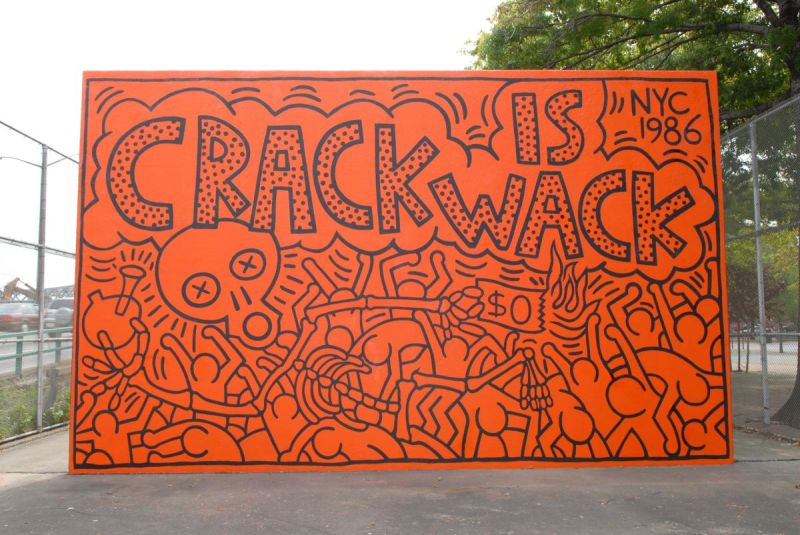Keith Haring is known and loved across the city and across the world for his bold, rhythmic artwork. Although he hailed from Pennsylvania, his public art and his open-minded community-oriented ethos is synonymous with New York City. His preferred outlets included blank advertisement space in subway cars and murals in public parks, foregoing the elitism and conventionality associated with galleries and museums and making his art accessible to the everyday NYC resident. The renowned artist died in 1990, but his spirit lives on in his artwork, which can still be found publicly on display throughout the city.
The Lesbian, Gay, Bisexual, and Transgender Community Center, West Village
Haring crafted Once Upon a Time inside The Center as a celebration of gay male sexuality prior to the AIDs epidemic. This mural is part of a large collection of art on permanent display at The Center in the West Village that the public is more than welcome to tour. If you can’t make it to The Center in person, the organization is part of Google’s cultural institutions initiative and you can tour the mural, as well as the other art on display, from the comfort of your couch.

(Source: NYC Parks)
128th & 2nd Ave, East Harlem
Perhaps the best known of Haring’s work, this East Harlem mural was inspired by the crack epidemic and was painted at a handball court in the park. Though originally “executed independently” (aka graffiti, people!), the city’s parks department immediately took responsibility for the mural, its protection, and preservation.
Please note: According to the Keith Haring Foundation, the Crack is Wack mural is under wraps until the NYC DOT completes repairs to sections of the FDR Drive adjacent to the park. Completion of the roadwork and unveiling of the mural are estimated for 2018.
(Source: Bill R via Flickr Creative Commons)
Woodhull Medical & Mental Health Center, Bedford-Stuyvesant
Generally, hospitals are pretty miserable places. But patients at the Woodhull Medical Center in Bed-Stuy have the perk of enjoying this mural during their stay. Painted over the course of three days in 1986 and restored in 2007, the 700-foot display showcases Haring’s iconic individuals in bright, primary colors and continues to bring a smile to patients’ faces today. No need to be admitted as a patient to check out this mural; it’s located in the lobby of the outpatient unit.
(Source: NYC Parks)
Tony Dapolito Recreation Center, West Village
Located in the West Village, this mural spans the width of what was once called the Carmine Street Pool and features bright fish and happy children. Visitors to the Tony Dapolito Recreation Center (a NYC parks facility) can view the mural, which was refurbished in 2014, on the wall that separates the rec center from James J. Walker Park.
(Source: New York Historic Society)
New York Historical Society, Upper West Side
Section of the Pop Shop Mural
As part of his mission to make art accessible to the public, Haring opened the Pop Shop in 1986, a store that sold buttons, magnets, and other affordable tchotchkes featuring his artwork. Though frowned upon by much of NYC’s elite art scene, the public reaction was overwhelmingly positive and the shop even garnered support from renowned contemporaries of Haring like Andy Warhol. Haring decorated the entire shop with a bold black and white mural in his signature style and when the shop closed in 2005, his foundation donated a portion of the mural to the New York Historical Society. It can now be viewed on the ceiling above the museum’s admissions desk.
(Source: The Dream Being Blog)
Battery Park, FiDi
Located just outside the park at 17 State Street, this yellow and red aluminum sculpture showcases Haring’s signature style and energy in three-dimensional form. A larger than life pair of dancers interlocks arms and kick their legs in a bold and lively caper, hopefully bringing a bit of levity to Fi-Di’s lawyers and finance folk on their lunch breaks.
(Source: The Public Art Fund)
Cathedral of St. John the Divine, Morningside Heights
This triptych on display at the impressive cathedral in Morningside Heights near Columbia University was completed by Haring just weeks before his passing. Though at first glance it appears to be a departure from his vibrant signature style, like much of his 1980s work, this sculpture is crowded with figures and equally as exuberant as his famous outdoor murals.
Related